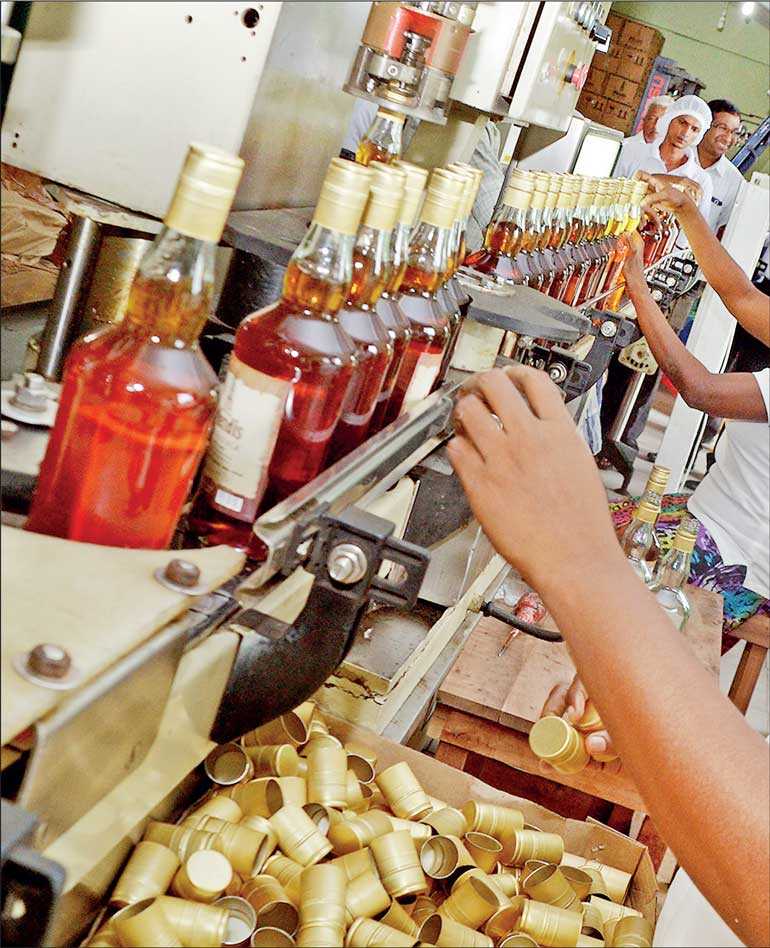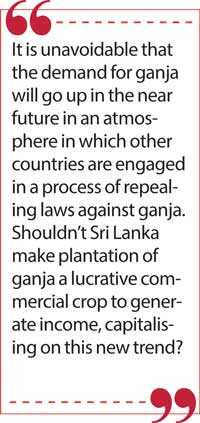Wednesday Dec 11, 2024
Wednesday Dec 11, 2024
Friday, 15 March 2019 00:05 - - {{hitsCtrl.values.hits}}

I hope to begin this article with arrack and end up with ganja. Since I have chosen to write about arrack, I think it is fair that I should clarify my relationship with it for the knowledge of the reader. 
Frankly speaking, I consume a moderate amount of 100-150 ml alcohol daily only in the night. I must also admit that this habit has no way affected my life or that of the members of my family adversely because it is being pursued with a high sense of discipline and self-control. So much so, my habit of drinking alcohol has not caused my children to become alcoholics themselves.
The blue collar workers or tired and overworked manual labourers usually consume alcohol as a means of finding relief from physical fatigue. It is also likely that those who are engaged in intellectual pursuits to incline to do the same as a relief from intellectual fatigue. In my opinion, consumption of alcohol in moderation and in responsible, safe and sensible manner will not cause any harm to health of a person or the society. However, addiction to alcohol and neglect of one’s wife and children on account of alcohol consumption can be considered a grave offence.
It is natural for people to disengage themselves from humdrum routine and mechanical way of life they lead, at least for a short while, and seek some relief in engaging in apparently useless but pleasant activities. I don’t think there is a big difference between the inspiration one derives from enjoying an exquisite piece of art, literature or music and the pleasure derived from having a meaningful discussion with selected companions while sipping a drink. The civilised world though does not encourage alcoholic drinks, nor does it not impose rigid taboos on it.
Alcohol policy in Sri Lanka
But Sri Lanka has a very rigid policy on alcohol. The price of a bottle of arrack in Sri Lanka, compared to the average income level of the country is relatively high and is almost equal to that of a bottle of a good brand of whisky in Europe. The price of a bottle of all types of arrack except ‘Gal’ arrack (molasses based) is approximately Rs. 2,000 or more. The excise duty that the Government earns from a bottle of arrack can be nearly Rs. 1,500.
Sri Lanka can be described as a lethargic and stupid country that depends on tax money derived from sale of arrack under the pretext of a vociferous Government’s campaign against the use of alcohol (‘Mathata Thitha’). Last year the tax on liquor earned by the Government had been Rs. 72.6 billion.
Increase of price of liquor has not resulted in people reducing consumption. It only results in a change in alcohol consumption pattern and more and more consumers shifting to ‘kasippu’ or illicit liquor when the price is not affordable. The outcome of this trend is more dangerous and destructive. On the other hand, the increase in price might cause a corresponding reduction in the income the arrack drinkers share with their families. This is a situation equivalent to taking revenge from innocent family members.
According to research done by Dr. Priyanga Dunusingha of Colombo University, the share of kassipu in the liquor market is 49%. As per a paper submitted by G.D. Dayaratne of the Institute of Policy Education, this share is as high as 65%; 30% of the remainder constitutes of hard liquor and the balance 5% of beer. The alcohol policy of the Government of Sri Lanka can be considered an extra thrust to increase the demand for kasippu.
History of liquor consumption
Alcoholic beverages have been used by most cultures and its history can be traced back to old civilisations that prevailed in the world. Archaeological research has revealed that Persia or ancient Iran had consumed wine as far back as 5000 BC. By 3400 BC Egypt had a distillery which could produce 300 gallons of beer per day. The workers who built the Great Pyramids, for example, were allotted a daily beer ration. 
India, since the times of Indus valley civilisation (3000 BC-2000 BC) had a kind of alcoholic beverage called Sura manufactured from rice, corn, cane sugar and grapes. ‘Ramayana’ and ‘Mahabharata,’ the two great Indian epics, carry references to the use of Sura. In Greek civilisation too, wine had a great recognition. Socrates, who could be considered the first martyr who sacrificed his life in the name of the right to express truth, was not an alcoholic. But, according to Plato, Socrates drank wine on rare occasions and had proved to be a prolific drinker without ever faltering. An impressive feat, indeed.
The Mayan civilisation had a popular kind of wine made of bees’ honey. In the ancient past Mexico had its alcoholic beverages made of pineapple. Spain and Brazil had manufactured their liquor with cassava. Ancient Africa had its liquor made of banana and thanahaal or foxtail millet.
Though spirit-based liquor was introduced to Sri Lanka by the Europeans, the natives knew the art of distilling toddy from the sap of kithul palm, coconut and palmyra. But they did not know the art of distilling alcoholic beverages from rice or any other grains.
According to the ‘Mahavamsa,’ the great chronicle, King Aggabodhi VIII who ruled Sri Lanka in the 9th century AD had prohibited carrying meat and alcoholic beverages to the city on Poya days. King Sena V had been addicted to alcohol and after taking drinks he had behaved like an animal and due to excessive consumption of alcohol had succumbed to death while he was still young. This illustrates that the consumption of meat and alcoholic beverages was common in Sri Lanka long before the country was captured by the Europeans. We must therefore accept the fact that the ancient and medieval Sinhalese were neither vegetarian nor teetotal.
Chewing betel, too, has some intoxicating effect. Betel chewing had been an age-old practice associated with the cultural milieu of the country. Not only men, even women and bhikkhus were addicted to this practice.
Sri Lanka and arrack
It was John D’Oyly who launched a subversive scheme to make Sri Wickrama Rajasinghe, the last King of Kandy, an alcohol addict. With the support of his secret agents, he managed to introduce European alcoholic drinks to the king. It constituted a part of the shrewd stratagem employed by him for the British to capture the Kandyan kingdom.
It was the great grandfather of J.R. Jayewardene who had served as the main spy of John Doyley in this scheme while the great grandfathers of Ponnambalam Ramanathan and S.W.R.D. Bandaranaike had served as the language interpreters. The British Governor had donated to them a large extent of land in appreciation of the contribution made by them in facilitating the British to capture the king and the Kandyan kingdom. These can be considered the facts hidden by the historians who wrote the modern history of the country. Arrack had played a unique role in shaping the modern history of Sri Lanka. It can be considered the main economic source of the rise of the Sinhala capitalist class during the 19th century. The Buddhist revival movement had been mostly financed by the arrack renters. Except for a few (Anagarika Dharmapala and D.B. Jayatilleke), most of the leaders of the temperance movement were the children of arrack renters. It is they who eventually become the pioneers and the leaders of the independence movement of Sri Lanka.
A book written on Selestina Dias by Manel Thampoe which can be considered a unique biography of the former notwithstanding it being a small publication refers to an interesting incident involving a question of conscience arisen in an arrack renter who had performed a leading role in the temperance movement. 
Visakha Vidyalaya of Colombo can be considered a school founded by the generosity of Selestina Dias who was popularly known as ‘Renda Nona’. It was she who managed the plantation, liquor and property interests of Jeremias Dias, her husband, upon his death. Arthur Dias, the second son of Selestina Dias, was a prominent leader of the temperance movement. He served as the manager of his mother’s liquor business while being engaged in the temperance movement.
The book says that Arthur Dias, having realised the moral contradiction between the two mutually-conflicting roles that he had been playing as an arrack renter and a leader of the temperance movement, managed to persuade his mother to abandon the arrack business. But the other leaders of the temperance movement lacked the conscience that Arthur Dias possessed. Even Anagarika Dharmapala does not seem to have been concerned about this issue in selecting leaders for the temperance movement.
The arrack renters were rich business men and what they sought was recognition in national level. This will help us form an opinion of our own on the true character of the leaders of the independence movement of Sri Lanka and the independence itself that we gained eventually.
About ganja
Now I wish to switch from arrack over to ganja. The terms kansa, cannabis, hashish, and hemp are also used to denote ganja. The term ‘kansa’ is used to refer to the plant as a whole, while ‘ganja’ is used to refer to the flowering head. The proposal I am going to put forward here might annoy some people. It is not a proposal by me but a proposal submitted to me by a learned youth. Though he agreed to write about it, he did not do it. He now lives in a foreign country, where he has been for some time. Here, I have chosen to defend his proposal, of which I am in very much in favour.
Before presenting his proposal, it is important that some background information is produced as a prelude to it. Ganja, too, has a very long history going back to over more than 10,000 years. Ganja or cannabis is indigenous to Central Asia and the Indian subcontinent. Both India and China had recognised ganja as a plant species having psychoactive properties that had an impact on the mind of the people.
Archaeological excavations in Oki island of Japan have revealed that the history of ganja in this island goes back to 8000 BC. Ganja had been used as a food item, medicine and alcohol as well as hemp for manufacturing strong copper. The Chinese had later used hemp to make clothes, shoes, ropes, and an early form of paper. Hemp is called ganja in Sanskrit and other modern languages. Some scholars suggest that the ancient drug known as soma, mentioned in the Vedas, was made of cannabis. Ganja is referred to as ‘thrailokya vijayaa pathran’ in Ayurveda which means that it can conquest the three worlds. It was ancient Assyrians who had used ganja for smoking for the first time. During Napoleon’s invasion of Egypt in 1798, being an Islamic country, alcohol was not available in Egypt. In lieu of alcohol, Napoleon’s troops resorted to trying hashish, which they found to their liking.
In Sri Lanka too, ganja appears to have been used as a kind of medicine. The people of the dry zone used ganja as an ingredient in cooking ‘dhada mas’ or the flesh of game. They used a kind of aggala or a sweet ball made of flour and sugar mixed with ganja as a worm treatment for children. They had also eaten a kind of kurakkan roti mixed with ganja.
In the late 1800s, several countries in the Islamic world banned ganja for the first time. Thereafter, during the19th century, ganja was banned in the countries which came under colonial rule. At the start of the 20th century, more countries continued to ban ganja. Along with that, the cultivation, possession, use and sale of ganja had been outlawed and declared criminal offences.
The new world trend
The international scenario about ganja began to change in the 21st century. The Government of Netherlands launched a research program in 1972 to distinguish between harmful and less harmful alcoholic products. It revealed that ganja was the least harmful (negligible) of all other narcotics and alcoholic products.
Along with these findings, the law that prohibited consumption and possession of ganja was repealed and the right to keep 30 grams of ganja in possession was granted. This led many countries relooking their policies on ganja and revoking laws against possession and consumption of ganja and inflicting punishments.
This trend did not stop at that. It gathered momentum in Uruguay. In 2013, the State of Uruguay legalised the consumption, possession, selling and cultivation of ganja. In 2017, Canada joined the bandwagon. Thereafter, 33 States of America followed suit. Belgium is the latest addition. New Zealand has already fixed a date for a plebiscite before it being legalised. India is also in an imminent stage of legalising ganja.
This trend is spreading rapidly all over the world. It is an unavoidable trend that cannot be reversed. The day in which the laws against ganja will be removed from all over the world will not be very long. Along with that, it will be unavoidable for the demand for strong drugs like heroin and cocaine and alcoholic beverages of spirit type to go down, giving way to the increased demand for ganja.
Sri Lanka is still in the dark as far as the rapid changes taking place in global level are concerned. It remains at a stupid level without having any idea about the global trends, still continuing to impose fines which include imprisoning for possession and consumption of ganja. The punishment that can be imposed by the Judiciary for possession of one kilogram of ganja is life imprisonment.
More than this situation, what is really important is the point of view of the youth I mentioned above. What I am going to put forward here is a proposal which is a combination of his view as well as that of mine. The farmers of Sri Lanka are in a dire state of poverty and misery. The agricultural sector including paddy and tea cultivation is also in an equally unfortunate level.
It is unavoidable that the demand for ganja will go up in the near future in an atmosphere in which other countries are engaged in a process of repealing laws against ganja. Shouldn’t Sri Lanka make plantation of ganja a lucrative commercial crop to generate income, capitalising on this new trend?
Sri Lanka has an ideal climatic and soil conditions favouring cultivation of ganja. Removal of laws against ganja alone would be a thrust to make it a commercial crop. It will invariably become a good source of income and foreign exchange earner for the country, which at present is buried in a massive burden of debt. Further, it will become a cash crop that would help make a revolutionary change in the life of the farmers. Shouldn’t we make use of this opportunity?
I must say that I am not the first person or the only person in Sri Lanka to write about the importance of ganja. I know very well that the late Professor Gunapala Dharmasiri, retired Chair of the Philosophy Department at the University at Peradeniya and one of Sri Lanka’s foremost Buddhist scholars who was passionately interested in Sri Lanka’s Ayurvedic tradition and was a strong advocate for preserving Sri Lanka’s medicinal plants, in his book titled ‘The Nature of Medicine’ has presented an interesting analysis of the mistaken views that prevail about ganja and the importance of preserving the Ayurvedic medical tradition.
Unfortunately, the copy of the book I had in my collection had been either misplaced or lost and I came to know of it only when I looked for it to obtain some information to write this article. Manik Sandrasagra, a well-known cinematographer, was another person who had expressed his views on ganja boldly.